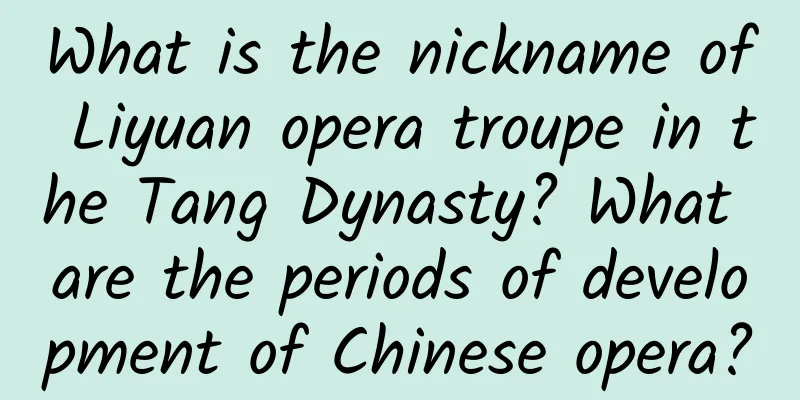What is the nickname of Liyuan opera troupe in the Tang Dynasty? What are the periods of development of Chinese opera?

|
Friends who like and understand opera know that the Ming and Qing dynasties were the heyday of opera. During this period, opera was developing rapidly both among the people and in the palace. Many opera troupes with local characteristics appeared in various places. Later, opera troupes from various places came to Beijing to develop and formed my country's national opera "Peking Opera". What place in the Tang Dynasty did the nickname of the Liyuan opera troupe refer to? Let's find out together! Contents of this article 1. What place in the Tang Dynasty was the nickname of the Liyuan opera troupe? 2. What are the development periods of Chinese opera? 3. The clothes in opera include 1What place in the Tang Dynasty was the nickname for the Liyuan opera troupe?The nickname of the Liyuan Opera Troupe was originally a place name in Chang'an, the capital of the Tang Dynasty. Because Emperor Xuanzong of Tang (Emperor Minghuang of Tang) Li Longji taught performing artists here, it was later associated with opera art and became a synonym for art organizations and artists. Liyuan was originally another name for opera troupes in ancient times. In my country, opera troupes and theater groups are usually called "Liyuan" and opera actors are called "Liyuan children". Liyuan children are divided into sitting, standing, small, male and female parts. The sitting part is generally composed of outstanding actors, the standing part is composed of ordinary actors, and the small part is a children's performance team. The main responsibility of the Liyuan was to train people who played musical instruments. It was one of the three major institutions along with the Taichang Temple, which was responsible for ritual music, and the Neiwai Jiaofang, which was responsible for performing songs, dances and other kinds of music. 2What are the periods of development of Chinese opera?1. Pre-Qin to Mid-Tang The period from the pre-Qin Dynasty to the mid-Tang Dynasty was the embryonic stage of Chinese opera. Whether it was the "Song" in the "Book of Songs" or the "Nine Songs" in the "Chu Ci", they were all lyrics for sacrificial offerings to gods. By the Han Dynasty, they had gradually evolved into singing and dancing. Later, from the Han Dynasty to the mid-Tang Dynasty, "Jiao Di" and "Canjun Xi" appeared. These were all operas in their embryonic stage. 2. Middle and late Tang Dynasty The middle and late Tang Dynasty was the period of the formation of opera. At that time, the Tang Dynasty was strong and the artistic atmosphere was high. Opera developed rapidly and the art of drama gradually took shape, laying the foundation for the development of drama in later generations. 3. Song and Jin Dynasties The Song and Jin dynasties were the period of development of opera. After the Song Dynasty, zaju emerged, and the Jin Dynasty also saw the emergence of "yuanben" and "zhugongdiao" in the form of storytelling, which laid the foundation for the development of opera both in terms of music structure and content. 4. Yuan Dynasty The Yuan Dynasty was the mature period of opera. The zaju of the Yuan Dynasty was extremely famous. It achieved a qualitative leap on the original basis. It also possessed the basic characteristics of drama and marked the entry of Chinese drama into a mature stage. 5. Ming and Qing Dynasties The Ming and Qing dynasties were a prosperous period for opera. During this period, opera developed rapidly both among the people and in the court. Many opera troupes with local characteristics emerged in various places. Later, opera troupes from all over the country came to Beijing to develop and formed my country's national opera "Peking Opera". 3The clothes in the opera include1. Rich Clothes The term "rich and noble clothes" actually refers to "poor clothes", which are clothes with irregular folds of various colors decorated with silk to indicate that the clothes are tattered and very poor. They are mostly worn by impoverished scholars, who later became rich, so they are called "rich and noble clothes". 2. Python Mang refers to the dragon robe and mang robe in opera, which are made to imitate the mang robe of the Ming Dynasty. In ancient my country, the hierarchy of production was also reflected in opera costumes. At that time, mang robes were mostly used by emperors and concubines. The mang robes in operas have various styles. In the "big suitcase" for costumes, there will be 10 male mang robes and 5 female mang robes. 3. Official uniform Official uniforms are made in imitation of the "round-collar shirt" which was the official uniform of Ming Dynasty cultural relics. The main feature is that there are two square patches on the front and back of the chest, embroidered with birds or beasts. The colors are used to distinguish the official positions. Official uniforms are divided into male and female official uniforms. 4. Cape The pejamas are made by imitating the jackets of the Ming Dynasty through artistic processing. They are divided into male pejamas and female pejamas. When a couple appears at the same time, they will wear pejamas with the same pattern and color, which is also called "pair of pejamas". In addition, different patterns and styles of pejamas represent different identities. 5. Open the cloak The cloak is embroidered with gold, silver or colorful threads with gold embroidery of ferocious beasts. It is mainly divided into round flower cloak and beast cloak. Sheng roles mostly wear round flower cloak, while Jing roles mostly wear beast cloak. 6. Pleats The pleated robe is also known as the "Daoist robe". It is made from the Ming Dynasty's slanting collar "big sleeves" and is the most commonly used and most common type of robe in drama. It can be worn by emperors and generals, as well as ordinary people. 7. Special clothing There are many types of special clothes, including palace clothes, eunuch clothes, dragon clothes, Bagua clothes, crane cloaks, monastic robes, cassocks, monk robes, Eight Immortals clothes and sin clothes. |
<<: Still on a low-carb diet? Eat more good carbs!
>>: You won't get syphilis from bathing together, but if...
Recommend
To prevent diabetic neuropathy, can methylcobalamin and vitamin B12 replace each other?
I met a patient who was a diabetic and wanted to ...
Treatment of gonococcal urethritis
As people are busy with their lives, life is alwa...
What medicine should I take for menopausal menstruation?
Excessive menstrual bleeding is actually a common...
The elderly man had hunchback and pulmonary insufficiency and could not lie flat. The doctor broke the routine and changed him from sitting to "standing" to ensure the success of the operation
Due to the special body position requirements of ...
Can I take a pregnancy test a few days after having sex on the day of ovulation?
Many expectant parents, thinking that they want t...
What is the cause of female vulva itching and yellow leucorrhea?
If a woman has symptoms such as vulvar itching an...
Seize the golden season for growth and help your children grow up!
Spring is coming Everything is revived and full o...
What causes nipple pain during ovulation?
The ovulation period refers to the period of time...
[Fat Bear Science] After the Dragon Boat Festival, the disease will awaken! This way of conditioning will make your body healthier
The annual Dragon Boat Festival is just a few day...
Which is the best painkiller for dysmenorrhea?
Many people know that taking painkillers to relie...
Leep knife treatment of cervical hypertrophy
The sentence "Who made women" is very w...
What causes fungal vaginitis?
The incidence of candidal vaginitis is getting hi...
What are some tips for women's health care?
Women in our lives need love and protection, beca...
What is a coastline? How is its length measured?
Coastline change refers to the retreat or advance...
Many people come into contact with these 5 carcinogens hidden in their homes every day without knowing it! Check to see if you are among them.
In our daily lives, there are some carcinogens th...









